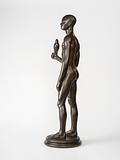Svend Rathsack originally trained as a painter at the Royal Danish Academy of Fine Arts in Copenhagen, graduating in 1907. After a few years of painting and having made several trips to Southern Europe and North Africa, he decided to devote himself to the art of sculpture despite his lack of schooling in this field. ‘I now want to
solely be a Sculptor; I have no Sense for Colour. I can’t paint at all, I think,’ he stated in an interview in April 1914.
[1] At this time he had just won the Eibeschütz Prize for the sculpture
Adam Newly Created,
[2] which would be his breakthrough as a sculptor.
The Eibeschütz Prize was presumably instrumental in making it possible for Rathsack to travel to Paris in May 1914, where he spent a few weeks studying under the sculptor Antoine Bourdelle (1861–1928). He found several friends and colleagues in the French capital, and his works from this period include a headless plaster figure modelled on the same African man who, a short time before, had been the model for Johannes Bjerg’s (1886–1955)
Abyssinian.
[3] Upon returning to Copenhagen, Rathsack continued to work on his plaster figure, and a few years later it found full expression in the bronze statuette
Young Man with a Falcon, which C.L. David acquired in 1920.
The young, naked man is standing, looking alertly ahead with the bird perched on his right hand. His body is turned slightly, and there is a shift in the weight, resting primarily on his right foot. The strikingly elongated proportions testify to Rathsack’s interest in reworking the classical idiom, pulling it in a modern, mannered direction – a stylistic tendency seen in a range of works by young Danish sculptors in the 1910s.
Rathsack created numerous statuettes and sculptures from the mid-1910s and in the decades that followed, becoming one of the preeminent sculptors of his time. From the mid-1920s onwards, he did several major commissions for public art, including the
Maritime Monument on Langelinie (1923–1928), the
H.C. Lundbye Monument in Tivoli (1929–1930/1962) and the
Greenland Monument in Christianshavn (1931–1938).



